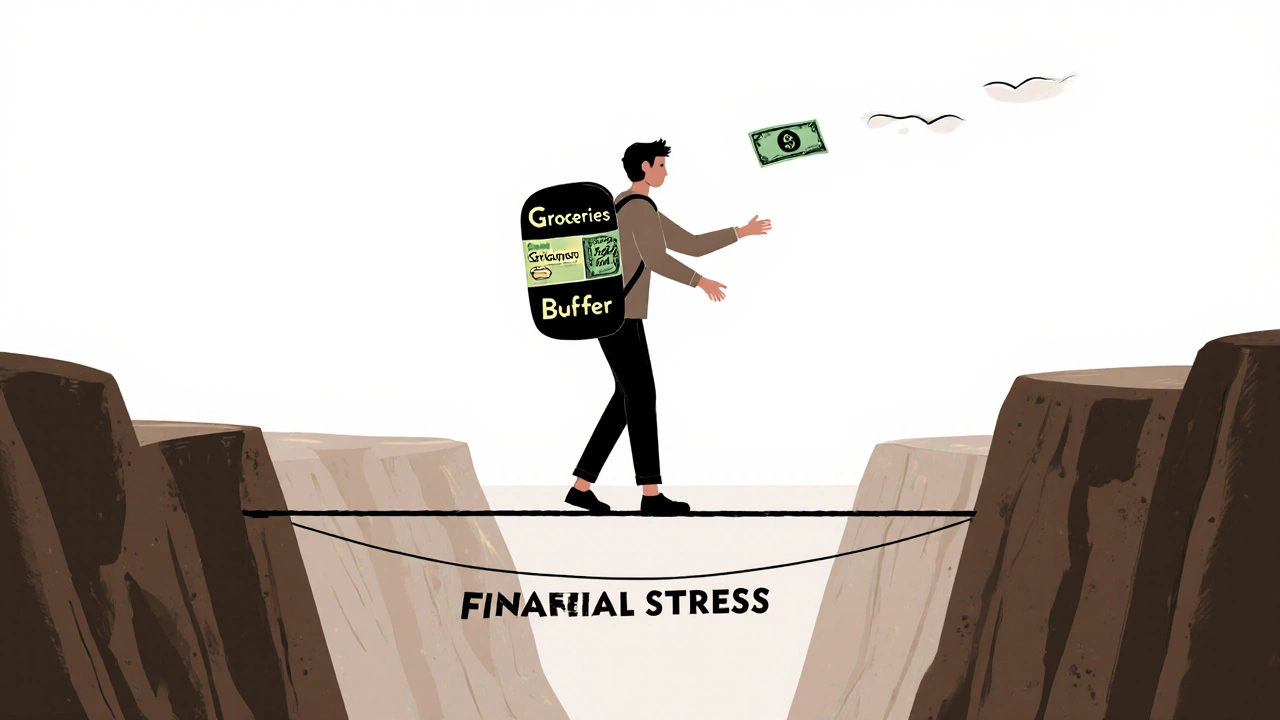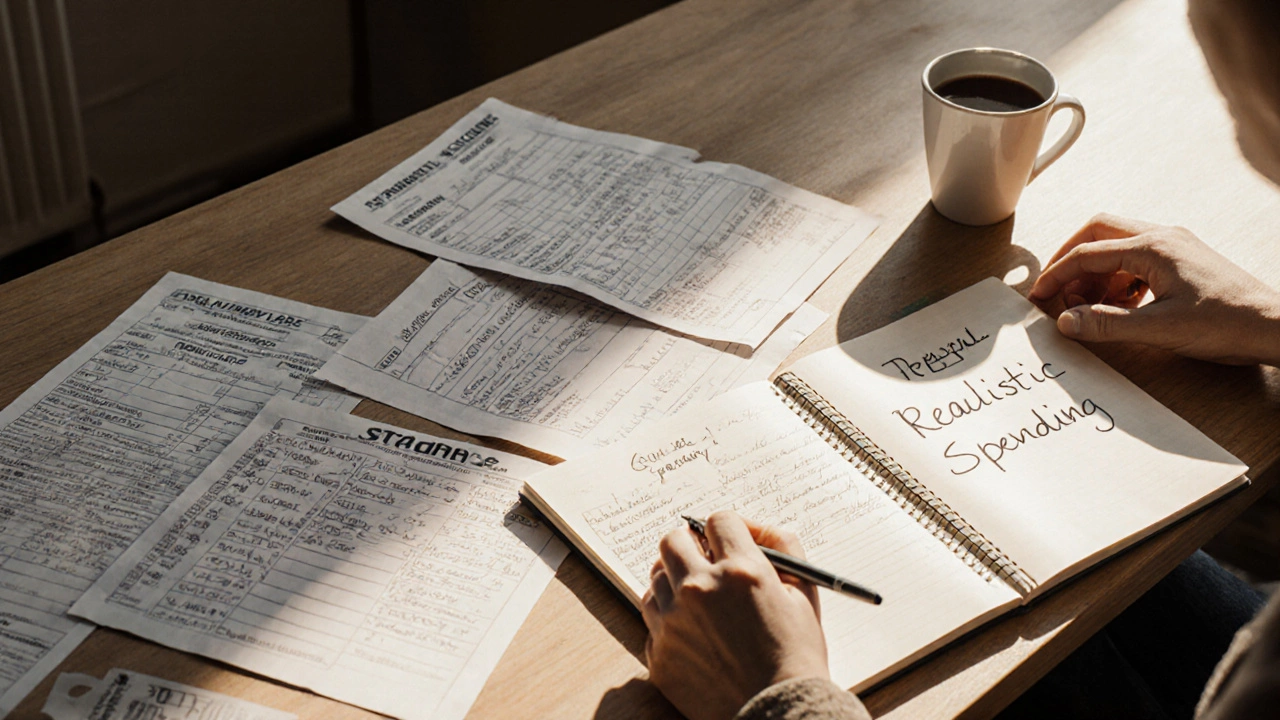Budget Realism Calculator
Most people think a budget is just a list of expenses and income. But if your budget doesn’t have the right structure, it won’t work-no matter how detailed it is. You might track every coffee and grocery run, yet still run out of money before payday. Why? Because a good budget isn’t about counting dollars. It’s about design. And there are three non-negotiable characteristics that make a budget actually stick.
It’s Realistic
A budget that ignores reality is just a wish list. You can’t cut out all dining out if you’re used to eating lunch out five days a week. You can’t save $1,000 a month if your take-home pay is $2,800 and you’re already paying $1,200 in rent. People fail budgets not because they lack discipline, but because they start with numbers that don’t match their life.
Try this: look at your bank statements from the last three months. Not what you wish you spent, but what you actually spent. That’s your baseline. If you spent $350 on groceries last quarter, don’t suddenly budget $150. Start at $350, then look for small, sustainable cuts-like switching to store brands or cooking one extra meal at home each week. Realistic budgets grow from data, not hope.
According to the Australian Bureau of Statistics, households in Sydney spend an average of 27% of income on food and groceries. If your budget says 15%, it’s not ambitious-it’s unrealistic. Fix the number to match your life, not your ideal.
It Includes Flexibility
Life doesn’t run on a spreadsheet. Your car breaks down. Your kid needs braces. Your partner gets a surprise medical bill. If your budget is rigid, one unexpected cost crashes the whole system. That’s when people give up: “I blew my budget, so why bother?”
A good budget builds in breathing room. Most experts recommend setting aside 5-10% of your income as a “miscellaneous” or “buffer” category. This isn’t for impulse buys. It’s for the things you can’t predict. Think of it like insurance for your finances. If you budget $4,000 a month, give yourself $200-$400 for surprises. When something pops up, you don’t steal from rent or groceries-you tap the buffer. Then you rebuild it over the next month.
Some people call this an emergency fund. But you don’t need $10,000 saved up to start. Just start with $20 a week. Put it in a separate account, even if it’s just a digital wallet. Over time, that buffer becomes your safety net. Without it, every small shock feels like a disaster.

It’s Action-Oriented, Not Just Tracking
Tracking your spending is useful. But if you’re only writing things down without changing anything, you’re doing data entry, not budgeting. A good budget tells you what to do next. It turns numbers into decisions.
For example, if your budget shows you’re spending $600 a month on subscriptions-Netflix, Spotify, gym memberships, cloud storage-you don’t just note it. You ask: “Which three can I cancel or downgrade?” Maybe you don’t need two streaming services. Maybe your gym membership is sitting unused. That’s not a number-it’s an action. And action creates results.
Good budgets have built-in triggers. If your dining-out category hits 80% of its limit by the 20th of the month, you pause. You cook. You plan. You don’t wait until the end of the month to say, “I overspent.” You adjust in real time. That’s the difference between a passive ledger and an active tool.
Apps like YNAB (You Need A Budget) or Australian tools like Pocketbook use this principle. They don’t just show you where your money went-they push you to assign every dollar a job before you spend it. That’s the key: money isn’t just tracked. It’s assigned. And assignment creates control.
What Happens When You Get These Three Right?
Let’s say you earn $5,200 a month after tax. You live in a one-bedroom apartment in Marrickville, pay $2,100 in rent, $400 on utilities, $700 on groceries, $300 on transport, and $500 on personal spending. That’s $4,000. You have $1,200 left.
A bad budget says: “Save $1,000.” Then you don’t. You feel guilty. You quit.
A good budget says: “I’m going to put $500 into savings this month. I’ll use $200 for my buffer. And I’ll reduce my phone plan from $80 to $50-saving $30 a month. I’ll check my spending every Sunday.”
It’s realistic: $500 savings is doable. It’s flexible: $200 buffer covers the unexpected. It’s action-oriented: you’re cutting your phone bill, not just watching your balance drop.
After three months, you’ve saved $1,500. You’ve paid off a $300 credit card balance. You didn’t feel deprived. You felt in charge.

Common Mistakes to Avoid
- Using last year’s income to plan this year’s budget-unless your income is stable, update it monthly.
- Ignoring irregular expenses like car registration, annual insurance, or holiday gifts. Spread them out monthly.
- Trying to do everything at once. Start with one category: groceries or subscriptions. Master that before moving on.
- Thinking you need perfect software. A simple spreadsheet or even pen and paper works if the three characteristics are there.
How to Build One in 3 Days
- Day 1: Pull your bank and credit card statements from the last 90 days. Add up your average monthly income and spending. Write down your top 5 expense categories.
- Day 2: Set realistic limits for each category based on your actual spending-not your dreams. Add a 10% buffer. Then pick one small change: cancel a subscription, switch to a cheaper phone plan, or cook one more meal at home.
- Day 3: Set a weekly 15-minute check-in. Every Sunday, ask: “Did I stay within my limits? Did I use the buffer? What’s one thing I can improve next week?”
You don’t need to be perfect. You just need to be consistent. And if your budget has these three traits-realistic, flexible, and action-oriented-it will work, even on a modest income.
What’s the biggest mistake people make with budgets?
The biggest mistake is creating a budget based on what they think they should spend, not what they actually do. If you earn $4,000 a month and spend $3,200 on essentials, you can’t suddenly budget $2,000 for essentials and expect to stick to it. Start with reality, then adjust.
Do I need an app to make a good budget?
No. Apps like YNAB or Pocketbook help automate tracking, but they don’t make a budget good. A notebook and pen work fine if your budget is realistic, flexible, and action-oriented. The tool doesn’t matter-how you use it does.
How much should I save each month?
There’s no universal number. The goal is to save what you can without breaking your budget. For many, that’s 5-10% of income. If you’re starting from zero, even $50 a month builds momentum. The key is consistency, not the amount.
What if my income changes every month?
Use your lowest recent monthly income as your baseline. Then treat any extra as bonus money. Put half into savings or your buffer, and use the rest for fun or debt payoff. This keeps you safe during lean months.
Should I budget for entertainment?
Yes, absolutely. Budgeting for fun isn’t a failure-it’s sustainability. If you cut out all enjoyment, you’ll burn out and quit. Give yourself a realistic amount for movies, dining out, or hobbies. That way, you stick with the budget long-term.

